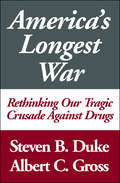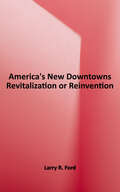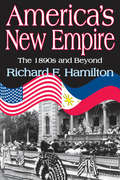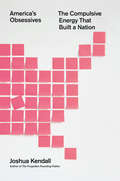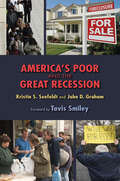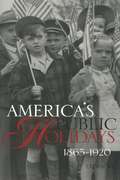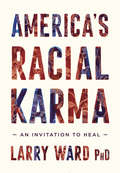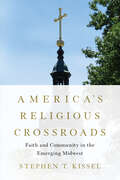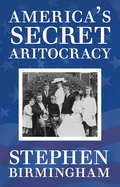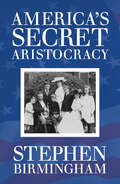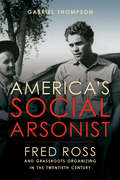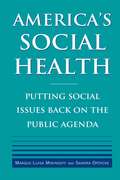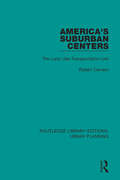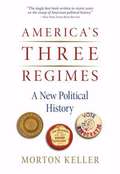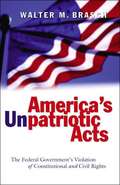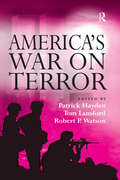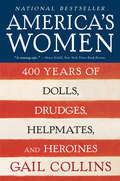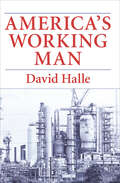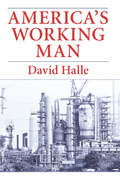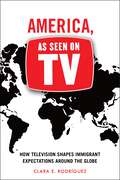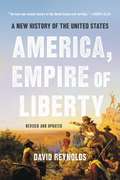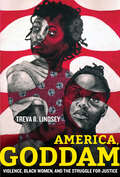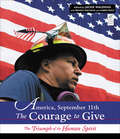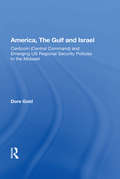- Table View
- List View
America's Longest War: Rethinking Our Tragic Crusade Against Drugs
by Steven B. Duke Albert C. GrossAmerica's war on drugs. It makes headlines, tops political agendas and provokes powerful emotions. But is it really worth it? That&’s the question posed by Steven Duke and Albert Gross in this groundbreaking book. They argue that America&’s biggest victories in the war on drugs are the erosion of our constitutional rights, the waste of billions of dollars and an overwhelmed court system. After careful research and thought, they make a strong case for the legalization of drugs. It&’s a radical idea, but has its time come?
America's New Downtowns: Revitalization or Reinvention? (Creating the North American Landscape)
by Larry R. FordWhat makes a good downtown, and why? Are today's downtowns, with their waterfront parks, festival markets, sports arenas, and cultural centers, more vibrant and lively than the "central business districts" of the nineteenth and early twentieth centuries? Was there ever a "golden age" of downtowns? In this book, noted urban scholar Larry Ford casts a critical and practiced eye on sixteen contemporary urban centers to offer an expert's view of the best―and worst―of downtown America. Ford begins with a brief history of U.S. urban development. He then explains his criteria for evaluating downtowns before proceeding with an on-the-street examination of the featured sixteen cities. Each is rated based on use of physical site, particularly for housing (unlike suburbs, Ford notes, most downtowns are located in challenging physical locales, such as harbors, rivers, hills, or peninsulas), street morphology, civic space, functional aspects (office space, retail stores, and convention centers), and the support districts in the fringe areas surrounding the downtown core. Ford concludes with a suggested model of downtown structure based upon the case studies and with a look at the possible effects of increasing globalization on the downtowns of the late twenty-first century. This book will appeal to those interested in urban studies, landscape studies, American studies, architecture, historic preservation and planning, and urban geography. Featured cities: Atlanta, Baltimore, Charlotte, Cleveland, Columbus, Denver, Indianapolis, Minneapolis, Phoenix, Pittsburgh, Portland, Providence, San Antonio, San Diego, Seattle, and St. Louis
America's New Empire: The 1890s and Beyond
by Richard F. HamiltonIn this volume, Hamilton deals with some of the antecedents and the outcome of the Spanish-American war, specifically, the acquisition of an American empire. It critiques the "progressive" view of those events, questioning the notion that businessmen (and compliant politicians) aggressively sought new markets, particularly those of Asia. Hamilton shows that United States' exports continued to go, predominantly, to the major European nations. The progressive tradition has focused on empire, specifically on the Philippines depicted as a stepping stone to the China market. Hamilton shows that the Asian market remained minuscule in the following decades, and that other historical works have neglected the most important change in the nation's trade pattern, the growth of the Canada market, which two decades after the 1898 war, became the United States' largest foreign market.The book begins with a review and criticism of the basic assumptions of the progressive framework. These are, first, that the nation is ruled by big business (political leaders being compliant co-workers). Second, that those businessmen are zealous profit seekers. And third, that they are well-informed rational decision-makers. A further underlying assumption is that the economy was not functioning well in the 1890s and that a need for new markets was recognized as an urgent necessity, so that big business, accordingly, demanded world power and empire. Each of these assumptions, pivotal elements in the dominant progressive tradition in historical writing, is challenged, with an alternative viewpoint presented.Hamilton presents a different, more complex view of the events following the Spanish-American War. The class-dominance theory is not supported. The alternative argued here, elitism, proves appropriate and more useful. This review and assessment of arguments about American expansion in the 1890s adds much to the literature of the period.
America's Obsessives: The Compulsive Energy That Built a Nation
by Joshua KendallWhen most of us think of Charles Lindbergh, we picture a dashing twenty-five-year-old aviator stepping out of the Spirit of St. Louis after completing his solo flight across the Atlantic. What we don't see is the awkward high school student, who preferred ogling new gadgets at the hardware store to watching girls walk by in their summer dresses. Sure, Lindbergh's unique mindset invented the pre-flight checklist, but his obsession with order also led him to demand that his wife and three German mistresses account for all their household expenditures in detailed ledgers.Lucky Lindy is just one of several American icons whom Joshua Kendall puts on the psychologist's couch in AMERICA'S OBSESSIVES. In this fascinating look at the arc of American history through the lens of compulsive behavior, he shows how some of our nation's greatest achievements-from the Declaration of Independence to the invention of the iPhone-have roots in the disappointments and frustrations of early childhood.Starting with the obsessive natures of some of Silicon Valley's titans, including Steve Jobs, Kendall moves on to profile seven iconic figures, such as founding father Thomas Jefferson, licentious librarian Melvil Dewey, condiment kingpin H. J. Heinz, slugger Ted Williams, and Estee Lauder. This last personality was so obsessed with touching other women's faces that she transformed her compulsion into a multibillion-dollar cosmetics corporation.Entertaining and instructive, Kendall offers up a few scoops along the way: Little do most Americans know that Charles Lindbergh, under the alias Clark Kent, sired seven children with his three German "wives." As Lindbergh's daughter Reeve told Kendall, "Now I know why he was gone so much. I also understand why he was delighted when I was learning German."
America's Poor and the Great Recession
by John D. Graham Kristin S. Seefeldt&“A thorough and enlightening survey of the impact and legacy of the Great Recession on low-income Americans . . . accessible and readable.&” —Journal of American Studies Millions entered poverty as a result of the Great Recession&’s terrible toll of long-term unemployment. In this book, Kristin S. Seefeldt and John D. Graham examine recent trends in poverty and assess the performance of America&’s safety-net programs. They consider likely scenarios for future developments and conclude that the well-being of low-income Americans, particularly the working poor, the near poor, and the new poor, is at substantial risk despite economic recovery. &“[This] primer on the state of America&’s poor in the wake of the Great Recession of 2007 to 2009 cuts through Beltway theater and provides a clear picture of the magnitude of poverty of the United States as well as the patchwork nature of social services targeting the poor.&” —Journal of Policy Analysis and Management
America's Public Holidays
by Ellen M. LitwickiFrom the revered Memorial Day to the forgotten Lasties Day, America's Public Holidays is a timely and thoughtful analysis of how the civic culture of America has been fashioned. By analyzing how holidays became a forum for expressing patriotism, how public tradition has been invented, and how the definition of America itself was changed, Ellen Litwicki tells the intriguing story of the elite effort to create new holidays and the variety of responses from ordinary Americans.
America's Racial Karma: An Invitation to Heal
by Larry WardImmediate, illuminating, and hopeful: this is the key set of talks given by leading Zen Buddhist teacher Larry Ward, PhD, on breaking America's cycle of racial trauma."I am a drop in the ocean, but I'm also the ocean. I'm a drop in America, but I'm also America. Every pain, every confusion, every good and every bad and ugly of America is in me. And as I transform myself and heal and take care of myself, I'm very conscious that I'm healing and transforming and taking care of America. I say this for American cynics, but this is also true globally. It's for real." So says Zen Buddhist teacher Dr. Larry Ward.Shot at by the police as an 11-year-old child for playing baseball in the wrong spot, as an adult, Larry Ward experienced the trauma of having his home firebombed by racists. At Plum Village Monastery in France, the home in exile of his teacher, Vietnamese peace activist and Zen teacher Thich Nhat Hanh, Dr. Ward found a way to heal. In these short reflective essays, he offers his insights on the effects of racial constructs and answers the question: how do we free ourselves from our repeated cycles of anger, denial, bitterness, pain, fear, violence? Larry Ward looks at the causes and conditions that have led us to our current state and finds, hidden in the crisis, a profound opportunity to reinvent what it means to be a human being. This is an invitation to transform America's racial karma.
America's Religious Crossroads: Faith and Community in the Emerging Midwest
by Stephen T. KisselBetween 1790 and 1850, waves of Anglo-Americans, African Americans, and European immigrants flooded the Old Northwest (modern-day Ohio, Indiana, Michigan, Illinois, and Wisconsin). They brought with them a mosaic of Christian religious belief. Stephen T. Kissel draws on a wealth of primary sources to examine the foundational role that organized religion played in shaping the social, cultural, and civic infrastructure of the region. As he shows, believers from both traditional denominations and religious utopian societies found fertile ground for religious unity and fervor. Able to influence settlement from the earliest days, organized religion integrated faith into local townscapes and civic identity while facilitating many of the Old Northwest's earliest advances in literacy, charitable public outreach, formal education, and social reform. Kissel also unearths fascinating stories of how faith influenced the bonds, networks, and relationships that allowed isolated western settlements to grow and evolve a distinct regional identity. Insightful and broad in scope, America’s Religious Crossroads illuminates the integral relationship between communal and spiritual growth in early Midwestern history.
America's Secret Aristocracy
by Stephen BirminghamAmerica's Secret Aristocracy is a report from inside the shush-shush inner circle of America's upper crust. Full of eccentric family members and well-sourced gossip, bestselling writer Stephen Birmingham spins an entertaining social history.
America's Secret Aristocracy: The Families that Built the United States
by Stephen BirminghamAn &“entertaining and perceptive&” history of America&’s most exclusive families, from the Brahmins of New England to the Grandees of California (The Washington Post). America has always been a constitutionally classless society, yet an American aristocracy emerged anyway—a private club whose members run in the same circles and observe the same unwritten rules. Here, renowned social historian Stephen Birmingham reveals the inner workings of this aristocracy. He identifies which families in which cities have always mattered, and how they&’ve defined America.America&’s Secret Aristocracy offers an inside look at the estates, marriages, and financial empires of America&’s most powerful families—from the Randolphs of Virginia and the Roosevelts of New York to the Carillos and Ortegas of California. With countless anecdotes about our nation&’s elite, including interviews with their modern-day descendants, Birmingham presents colorful portraits that capture the true definition, essence, and customs of America&’s aristocracy.
America's Social Arsonist: Fred Ross and Grassroots Organizing in the Twentieth Century
by Gabriel Thompson"A good organizer is a social arsonist who goes around setting people on fire."--Fred Ross Raised by conservative parents who hoped he would "stay with his own kind," Fred Ross instead became one of the most influential community organizers in American history. His activism began alongside Dust Bowl migrants, where he managed the same labor camp that inspired John Steinbeck's The Grapes of Wrath. During World War II, Ross worked for the release of interned Japanese Americans, and after the war, he dedicated his life to building the political power of Latinos across California. Labor organizing in this country was forever changed when Ross knocked on the door of a young Cesar Chavez and encouraged him to become an organizer. Until now there has been no biography of Fred Ross, a man who believed a good organizer was supposed to fade into the crowd as others stepped forward. In America's Social Arsonist, Gabriel Thompson provides a full picture of this complicated and driven man, recovering a forgotten chapter of American history and providing vital lessons for organizers today.
America's Social Health: Putting Social Issues Back on the Public Agenda
by Sandra Opdycke Marque-Luisa MiringoffCalling for a fundamental change in the focus of public policy in America, this book paints a vivid portrait of the nation's social health. Miringoff and Opdycke clearly show that social progress has stalled and the country's energies need to be directed at critical domestic issues in the years ahead.The authors propose a new agenda for monitoring America's social well-being built around sixteen key indicators of American life, such as infant mortality, teenage suicide, health insurance coverage, and affordable housing. They maintain that social conditions, like economic conditions, must be constantly monitored in order to have a clear sense of "how we are doing" as a society.The book builds on the work of the Institute for Innovation in Social Policy and argues that there needs to be a greater visibility for social issues - and a closer link between social reporting and public action - to better address the nation's social problems. It considers the critical role of the media in advancing public understanding of social issues, and examines important advances in the community indicators movement and international social reporting. Eye-opening and compelling, the book is a provocative centerpiece for policy debates and national initiatives on today's crucial domestic concerns.
America's Suburban Centers: The Land Use-Transportation Link (Routledge Library Editions: Urban Planning #6)
by Robert CerveroOriginally published in 1989, America’s Suburban Centers looks at how America’s suburban workplaces are being increasingly designed for automobiles rather than people. The emergence of sprawling office complexes devoid of housing, shops and other facilities is giving rise to regional congestion problems because of the ever-greater dependence on automobiles. This book argues that the low-density, single-use, and non-integrated character of America’s suburban centers is a root cause of declining levels of mobility and worsening traffic congestion.
America's Three Regimes: A New Political History
by Morton KellerHailed in The New York Times Book Review as "the single best book written in recent years on the sweep of American political history," this groundbreaking work divides our nation's history into three "regimes," each of which lasts many, many decades, allowing us to appreciate as never before the slow steady evolution of American politics, government, and law. The three regimes, which mark longer periods of continuity than traditional eras reflect, are Deferential and Republican, from thecolonial period to the 1820s; Party and Democratic, from the 1830s to the 1930s; and Populist and Bureaucratic, from the 1930s to the present. Praised by The Economist as "a feast to enjoy" and by Foreign Affairs as "a masterful and fresh account of U. S. politics," here is a major contribution to the history of the United States - an entirely new way to look at our past, our present, and our future - packed with provocative and original observations about American public life.
America's Unpatriot Acts: The Federal Government's Violation of Constitutional and Civil Rights
by Walter M. BraschWithin six weeks of the 9/11 terrorist attacks, Congress approved the USA Patriot Act, drafted in secret by the Department of Justice. Brasch, an award-winning syndicated columnist and university professor, looks at the effects of the Patriot Act on the nation and at the many civil rights violations conducted in the US, and by the US in foreign countries, during the three years after 9/11. Annotation ©2004 Book News, Inc., Portland, OR (booknews.com)
America's War on Terror
by Tom Lansford Patrick HaydenThis title was first published in 2003. 9/11 has become more than a date. It has become a noun, an idea shaped and moulded by the media and the American political establishment and the rationale for the subsequent "War on Terror". But what are the real factors that have motivated the world's sole remaining superpower to engage in a permanent war declared on an often elusive and abstract enemy and risk the very relationships that have augmented that global status? While the tragic events of the 11th of September 2001 caused a sea-change in the perception and realities of American security interests and its ability to project a foreign policy agenda, simplistic views that the resulting "War on Terror" is merely "reactionary warfaring" no longer carry any credibility. To fully understand the direction of contemporary US foreign policy requires a detailed understanding of the complex political, historical and personal processes which influence America's new sense of itself and its view of the world.
America's Women
by Gail CollinsAmerica's Women tells the story of more than four centuries of history. It features a stunning array of personalities, from the women peering worriedly over the side of the Mayflower to feminists having a grand old time protesting beauty pageants and bridal fairs. Courageous, silly, funny, and heartbreaking, these women shaped the nation and our vision of what it means to be female in America. <P><P>By culling the most fascinating characters -- the average as well as the celebrated -- Gail Collins, the editorial page editor at the New York Times, charts a journey that shows how women lived, what they cared about, and how they felt about marriage, sex, and work. She begins with the lost colony of Roanoke and the early southern "tobacco brides" who came looking for a husband and sometimes -- thanks to the stupendously high mortality rate -- wound up marrying their way through three or four. Spanning wars, the pioneering days, the fight for suffrage, the Depression, the era of Rosie the Riveter, the civil rights movement, and the feminist rebellion of the 1970s, America's Women describes the way women's lives were altered by dress fashions, medical advances, rules of hygiene, social theories about sex and courtship, and the ever-changing attitudes toward education, work, and politics. While keeping her eye on the big picture, Collins still notes that corsets and uncomfortable shoes mattered a lot, too. <P><P>"The history of American women is about the fight for freedom," Collins writes in her introduction, "but it's less a war against oppressive men than a struggle to straighten out the perpetually mixed message about women's roles that was accepted by almost everybody of both genders." <P><P>Told chronologically through the compelling stories of individual lives that, linked together, provide a complete picture of the American woman's experience, America's Women is both a great read and a landmark work of history.
America's Working Man: Work, Home, and Politics Among Blue Collar Property Owners
by David Halle&“An unusually deep and wide-ranging study&” by a sociologist who spent years listening to and living among workers at a New Jersey chemical plant (Journal of American Studies). Over a period of six years during the late 1970s, at factory and warehouse, at the tavern across the road, in their homes and union meetings, on fishing trips and social outings, David Halle talked and listened to workers of an automated chemical plant in New Jersey&’s industrial heartland—white, male, and mostly Catholic. He has emerged with an unusually comprehensive and convincingly realistic picture of blue-collar life in America during this era. Throughout the book, Halle illustrates his analysis with excerpts of workers&’ views on everything from strikes, class consciousness, politics, job security, and toxic chemicals to marriage, betting on horses, God, home-ownership, drinking, adultery, the Super Bowl, and life after death. Halle challenges the stereotypes of the blue-collar mentality and provides a detailed, in-depth portrait of one community of workers at a time when it was relatively affluent and secure. &“Absorbing reading.&”—Business Week
America's Working Man: Work, Home, and Politics among Blue-Collar Property Owners
by David HalleOver a period of six years, at factory and warehouse, at the tavern across the road, in their homes and union meetings, on fishing trips and social outings, David Halle talked and listened to workers of an automated chemical plant in New Jersey's industrial heartland. He has emerged with an unusually comprehensive and convincingly realistic picture of blue-collar life in America. Throughout the book, Halle illustrates his analysis with excerpts of workers' views on everything from strikes, class consciousness, politics, job security, and toxic chemicals to marriage, betting on horses, God, home-ownership, drinking, adultery, the Super Bowl, and life after death. Halle challenges the stereotypes of the blue-collar mentality and argues that to understand American class consciousness we must shift our focus from the "working class" to be the "working man. "
America, As Seen on TV: How Television Shapes Immigrant Expectations around the Globe
by Clara E. RodríguezFinalist, 2020 Latino Book Awards, Best Academic Themed BookThe surprising effects of American TV on global viewers As a dominant cultural export, American television is often the first exposure to American ideals and the English language for many people throughout the world. Yet, American television is flawed, and, it represents race, class, and gender in ways that many find unfair and unrealistic. What happens, then, when people who grew up on American television decide to come to the United States? What do they expect to find, and what do they actually find? In America, As Seen on TV, Clara E. Rodríguez surveys international college students and foreign nationals working or living in the US to examine the impact of American television on their views of the US and on their expectations of life in the United States. She finds that many were surprised to learn that America is racially and economically diverse, and that it is not the easy-breezy, happy endings culture portrayed in the media, but a work culture. The author also surveys US-millennials about their consumption of US TV and finds that both groups share the sense that American TV does not accurately reflect racial/ethnic relations in the US as they have experienced them. However, the groups differ on how much they think US TV has influenced their views on sex, smoking and drinking. America, As Seen on TV explores the surprising effects of TV on global viewers and the realities they and US millennials actually experience in the US.
America, Empire of Liberty: A New History of the United States
by David ReynoldsIt was Thomas Jefferson who envisioned the United States as a great "empire of liberty. ” This paradoxical phrase may be the key to the American saga: How could the anti-empire of 1776 became the world’s greatest superpower? And how did the country that offered unmatched liberty nevertheless found its prosperity on slavery and the dispossession of Native Americans? In this new single-volume history spanning the entire course of US history-from 1776 through the election of Barack Obama-prize-winning historian David Reynolds explains how tensions between empire and liberty have often been resolved by faith-both the evangelical Protestantism that has energized American politics for centuries and the larger faith in American righteousness that has driven the country’s expansion. Written with verve and insight,Empire of Libertybrilliantly depicts America in all of its many contradictions.
America, Goddam: Violence, Black Women, and the Struggle for Justice
by Treva B. LindseyOne of the Best Nonfiction Books of 2022, Kirkus Reviews "A righteous indictment of racism and misogyny."—Publishers WeeklyA powerful account of violence against Black women and girls in the United States and their fight for liberation. Echoing the energy of Nina Simone's searing protest song that inspired the title, this book is a call to action in our collective journey toward just futures.America, Goddam explores the combined force of anti-Blackness, misogyny, patriarchy, and capitalism in the lives of Black women and girls in the United States today. Through personal accounts and hard-hitting analysis, Black feminist historian Treva B. Lindsey starkly assesses the forms and legacies of violence against Black women and girls, as well as their demands for justice for themselves and their communities. Combining history, theory, and memoir, America, Goddam renders visible the gender dynamics of anti-Black violence. Black women and girls occupy a unique status of vulnerability to harm and death, while the circumstances and traumas of this violence go underreported and understudied. America, Goddam allows readers to understand How Black women—who have been both victims of anti-Black violence as well as frontline participants—are rarely the focus of Black freedom movements. How Black women have led movements demanding justice for Breonna Taylor, Sandra Bland, Toyin Salau, Riah Milton, Aiyana Stanley-Jones, and countless other Black women and girls whose lives have been curtailed by numerous forms of violence. How across generations and centuries, their refusal to remain silent about violence against them led to Black liberation through organizing and radical politics. America, Goddam powerfully demonstrates that the struggle for justice begins with reckoning with the pervasiveness of violence against Black women and girls in the United States.
America, September 11th: The Triumph of the Human Spirit (Call to Action Books)
by Karen Frost Brenda WelchlinTrue stories of compassion, heroism, and kindness in the midst of a historic tragedy.Every tragedy has its heroes, and there were many in the terrorist attacks on New York City and Washington, D.C., on 9/11 and in the difficult days that followed. In this inspiring volume, Jackie Waldman, author of The Courage to Give, has collected the dramatic stories of some of the firefighters, rescue workers, police, medics, relatives searching for missing loved ones, and everyday people who, in the face of horror, sprang into action to save lives and help their communities. From the ASPCA leader who lost a sister that day and went on to lead an effort to rescue abandoned pets from the area, to the music student who went to Ground Zero to play for the toiling rescue workers, these vivid accounts, written in the immediate aftermath, paint a vivid picture of that infamous event—and remind us of what is best in us even in the worst of times.
America, The Farewell Tour
by Chris HedgesIf you thought you knew Chris Hedges--be surprised. The globally renowned Pulitzer Prize-winner gives us an entirely new view of a nation in crisis in a stunning book that holds both liberals and conservatives to account--as rousingly pertinent for Canada as for the disoriented US. Beautifully written, it clarifies vividly and unforgettably the forces at play in our times.In astonishing, tough, first-hand reportage, Chris Hedges draws on stories from inside communities across America and reveals how the hurricanes of change have allowed an array of pathologies to arise: the opioid crisis, the retreat into gambling, the corporate coup d'état of government, the pornification of culture, the rise of magical thinking, the emboldening of violence and hate, the plagues of suicides, and the global upheaval caused by catastrophic climate change. These are just some of the physical manifestations of a society unravelling. Such ills presage a frightening reconfiguration of our lives--particularly in the face of our neighbour's degeneration as a world power.Donald Trump rode this disenchantment to power. Hedges--who was unsurprised by Trump's victory--shows how neither the left nor the right are addressing the systemic problems. Until the corporate coup d'état is reversed, these diseases will grow and ravage the country. A humane cry for a decent future, this remarkable book is our wake-up call to reality.
America, The Gulf, And Israel: Centcom (central Command) And Emerging U.s. Regional Security Policies In The Middle East
by Dare GoldThis book evaluates whether the military preparations made by US in the aftermath of Central Command's (CENTCOM) establishment, represent the kind of change in America's military relationship with the Middle East. It also evaluates the implications of the creation of CENTCOM for US-Israel relations.
